|

PHOENIX
Origin:
China
Feng Huang (Chinese)
Hou-ou (Japanese)
Feng (Hou)
represents male phoenix, yang, solar
Huang (Ou) represents female
phoenix, yin, lunar
Often depicted together with the Dragon,
either as mortal enemies or as blissful lovers.
Considered
equivalent to Red
Bird | Big Bird (Suzaku)
One of the guardians of the Four
Directions (Shishin)
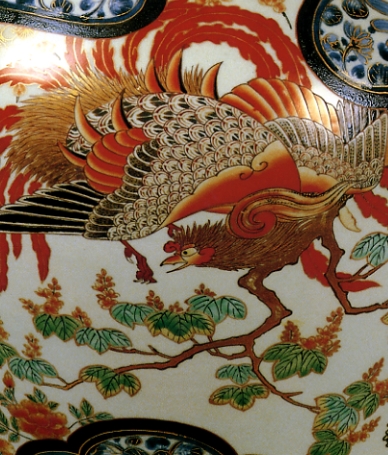
Phoenix, Image from Imari
Porcelain ware
Photo courtesy Nihon Toji Taikei, Vol. 19 (Imari
Ware)
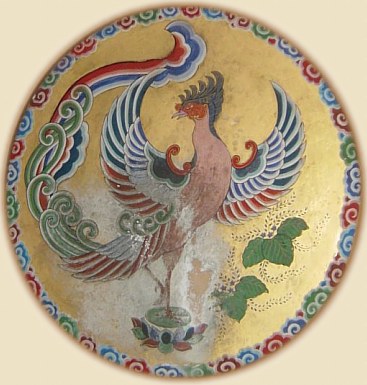
Phoenix Drum, Engaku-ji Temple Bell
Tower, Kita-Kamakura
INTRODUCTION
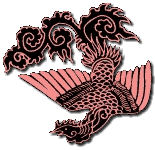 In Japan, as earlier in China, the
mythical Phoenix was adopted as a symbol of the imperial household,
particularily the empress. This mythical bird represents fire, the
sun, justice, obedience, and fidelity. In Japan, as earlier in China, the
mythical Phoenix was adopted as a symbol of the imperial household,
particularily the empress. This mythical bird represents fire, the
sun, justice, obedience, and fidelity.
According to legend
(mostly from China), the Ho-oo appears very rarely, and only to mark
the beginning of a new era -- the birth of a virtuous ruler, for
example. In other traditions, the Ho-oo appears only in peaceful and
prosperous times (nesting, it is said, in paulownia trees), and
hides itself when there is trouble. As the herald of a new age, the
Ho-Oo decends from heaven to earth to do good deeds, and then it
returns to its celestial abode to await a new era. It is both a
symbol of peace (when it appears) and a symbol of disharmony (when
it disappears). In China, early artifacts show the Phoenix (female)
as intimately associated with the Dragon (male) -- the two are
portrayed either as mortal enemies or as blissful lovers. When shown
together, the two symbolize both conflict and wedded bliss, and are
a common design motif even today in many parts of Asia (see below).
The Chinese compound term
Feng Huang means Phoenix. The Feng Huang was believed to control the
five tones of traditional Chinese music and to represent the Confucian
virtues of loyalty, honesty, decorum and justice. Its image first
appears on Shang artifacts of China's Western Zhou Period (11th
century BC to 771 BC).
The symbolism of the Chinese Phoenix
(Feng Huang) is strikingly similar to the symbolism of the
mythological Red Bird (Zhuque), also of
Chinese lore. In Japan, the Red Bird is pronounced Suzaku (same
Chinese characters). I believe the Red Bird is the same creature as
the Phoenix, although I may be wrong. The Red Bird is one of four
legendary Chinese creatures guarding the four cosmic directions (Red
Bird-S, Dragon-E, Tortoise-N, and the Tiger-W). The four appear
during China's Warring States period (476 BC - 221 BC), and were
frequently painted on the walls of early Chinese and Korean tombs to
ward off evil spirits.
The Asian Phoenix should not be
confused with the Phoenix found in Egypt and Greece -- that is a
bird of completely different feathers and traditions. The
Arabian-Western Phoenix, if you recall, is a solidary creature --
only one of its kind. When it dies, it dies in flames, and from the
ashes is born the next phoenix.
 |
Hou-ou
HISTORICAL
NOTES ON THE PHOENIX IN JAPAN
Below courtesy
www.aisf.or.jp/~jaanus/deta/h/houou2.htm
A mythical Chinese
bird, thought to have been introduced to Japan in the Asuka period
(mid 6th to mid 7th century AD). The phoenix has a bird's beak, a
swallow's jaw, and a snake's neck; the front half of its body is
thought to resemble a giraffe, the back half a deer. Its back
resembles a tortoise, and its tail is like a fish. It is often shown
in a paulownia tree (Chinese parasol tree, aogiri ), with bamboo
in the background, or surrounded by Chinese arabesque foliage
karakusa ??.
It became a popular decorative motif in the Nara period (late 7-8c),
and was used on a wide variety of items including textiles, mirrors,
chests, and lacquerware. Outstanding early examples of the phoenix
designs can be seen on the ceiling of Houryuuji Kondou Nishi-no-ma
(late 7c). Houou depicted on the back of mirrors were popular in the
Heian period (9-12c). Some of these used a Chinese style, but others
Japanized the houou motif, replacing arabesque foliage with Japanese
wild grasses, and changing the bird to resemble a blue magpie,
onagadori , or a crane,
tsuru . A
famous pair of houou statues, made of copper and measuring 1 metre
in height, can be seen on the roof of Byoudouin
Hououdo , Kyoto
(10c). Throughout the 13-19c the houou remained a popular design,
particularly on gold and silver lacquered boxes (see makie ) and for noh
costumes.
The original Chinese background of paulownia and bamboo was
gradually replaced by combinations of peonies, cherry blossoms,
crysanthemums, and seasonal Japanese wild flowers. The phoenix
appears on three crests, monshou, known as hououmaru, lit. phoenix
circle, tachi houou lit. standing
phoenix, and tobi houou lit. flying
phoenix. <end quote from JAANUS>
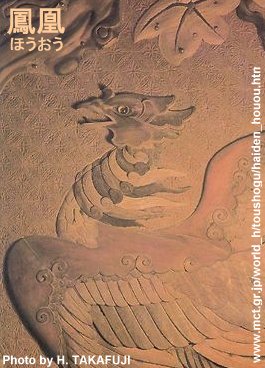
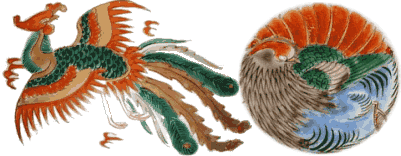
Above: Design on Edo-Period
bowl
(at the online store of blueandwhiteamerica.com)
The
phoenix is typically shown with spread wings,
in the act of
attacking "naga" with its strong claws.
Skt. "NAGA" means
all serpentines, snakes, and dragons.
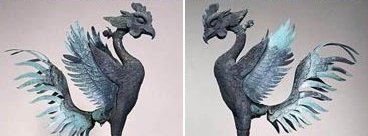
Above & Below
Heian Era,
11c, Atop Amida
Hall, Byodo-in, Kyoto
From early times (by at least China's
Han Period),
the Hou-ou was depicted as a male-female pair
facing each other.
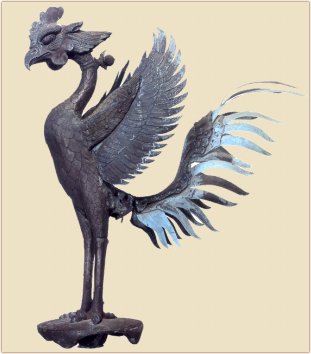
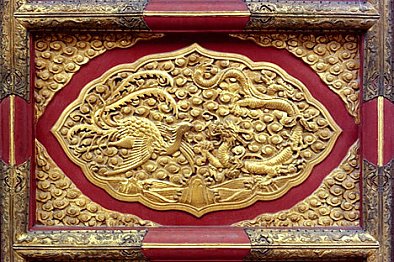
In China, the phoenix is
ofter paired with the dragon
as well -- the pair represent both
conflict and wedded bliss.
Above Photo: Hall of Heavenly
and Terrestrial Union (China)
Ornamental door design of Phoenix
(Empress) and Dragon (Emperor)
Courtesy
www.kiku.com/electric_samurai/virtual_china/beijing.html
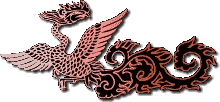 CHINESE
LORE CHINESE
LORE
tina.garnet.nu/eiko/
misc/eidolons2.htm
Feng, the
Chinese phoenix, had the head of a pheasant, the tail of a peacock,
the Five Cardinal Virtues inscribed on its body, and the most
enchanting song of any bird. Feng was associated with the primordial
forces of the heavens and was also the bringer of good fortunes, and
visions of the phoenix god were were omens of great luck in the near
future. Long (Dragon, East, Water) and Feng (Phoenix, South, Fire)
are most often depicted as enemies because of their opposing
elements (water and fire). Several Chinese folktales center around
the clash between the phoenix and the dragon. However, they're also
depicted as partners. Long is the male counterpart to the female
Feng, and together they can symbolize both conflict and wedded
bliss.
 |
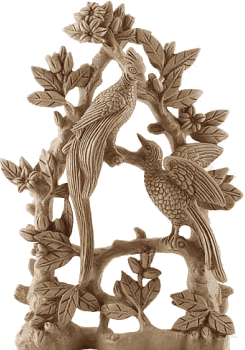 South - the Red Bird South - the Red Bird
"Phoenix"
is used as a translation for Feng, or Feng Huang, the sacred bird of
Chinese mythology. It has many miraculous attributes, but not
self-rejuvenation, and does not posess the Arabian phoenix's
propensity for self-immolation. It is usually portrayed as a
beautiful bird, virtually identical to an ornamental pheasant. Few
illustrations match its verbal description, as it is said to have
the front of a swan, the hinder parts of a unicorn, the throat of a
swallow, the bill of a chicken, the neck of a snake, the stripes of
a dragon, and the arched back of a tortoise.
Its plumage is
of the five mystical colours - black, white, red, green and yellow,
and it has twelve tail feathers, execept in years when there is an
extra month, when there are thirteen. It feeds on bamboo seeds,
lives in the branches of the dryandera tree, and drinks from
fountains of fresh water.
It is one of the four emblems of
royalty, usually associated with the Empress. The expression "Dragon
and Phoenix" signifies wedded bliss. In many respects its symbolism
has been confused and merged with that of the Red Bird, one of the
four Celestial Emblems (Walters)."
http://www.sempai.org/~felicia/myth.html
Above exerpts
from Derek Walters "An Encyclopedia of Myth and Legend: Chinese
Mythology" and Donald A. Mackenzie "Myths of China and Japan."
Unconfirmed Research
The Asian
phoenix is said to descend from the clouds only when a virtuous
ruler is born. It then alights only on the paulownia tree (though it
feeds on bamboo seeds). The paulownia is a real tree that bears
fragrant purple flowers, often depicted as white.
 |
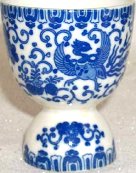 PHOENIX HISTORY,
CHINA PHOENIX HISTORY,
CHINA
http://www.fenice.com/phoenix.html
If we look at the
Shang ritual cups and bronze decorations of the Western Zou period
(around 3,000 years old) we find the images of five animals often
repeated: the lion, the fish, the deer, the dragon and the
phoenix.
The lion and the fish have origins in Buddhist
icons, while the other three are often found together, such as on
the inside of the coffin of the wife of the Marquis of Dai (2,200
years old). The four animals dragon, tiger, unicorn (or deer) and
phoenix are called "si ling" in Chinese, and with the passage of
time other animals such as the snake and the turtle were added to
this group of animals to be worshipped.
Right from the
earliest representations the phoenix has been shown with spread
wings, often in the act of attacking snakes with its strong claws.
During the Han period, 2,200 years ago, the Phoenix was used as a
symbol to indicate the direction south, and was often shown in a
pair of facing male and female birds. It may also be found paired
with the dragon, in which case the dragon represents the Emperor and
the phoenix the Empress.
An interesting difference between
the way the dragon and the phoenix are shown in decorations is that
the dragon is used to fill all the space available on a vase for
example, while the phoenix is used to fill specific space in the
decoration such as around trees, rocks, and flowers.
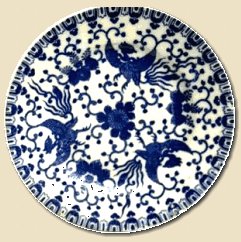 The symbol of the Fenice has been
used on objects in China, often in jade, for over 7,000 years,
originally on good-luck totems, and then, from around 2,000 years
ago to represent power sent from the heavens to the
Empress. The symbol of the Fenice has been
used on objects in China, often in jade, for over 7,000 years,
originally on good-luck totems, and then, from around 2,000 years
ago to represent power sent from the heavens to the
Empress.
A phoenix used to decorate a house showed loyalty
and honesty in the people who lived there. The phoenix was believed
to control the 5 tones of Chinese music and to represent the Confucian
virtues of loyalty, honesty, decorum and justice.
Considering
the importance of this mythical bird, it was inevitable that it
would also be used to decorate tombs and graves. The right to wear
jewellery showing the phoenix was reserved for important people, and
showed that the wearer was a person of high moral values.
 |
|